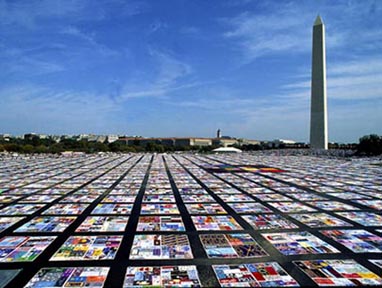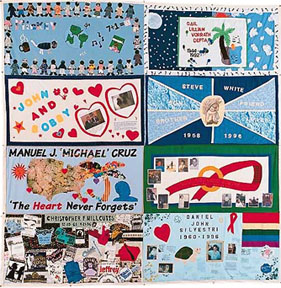.
Purposes of Art
Spiritual Art: Art In the
Service of Religion
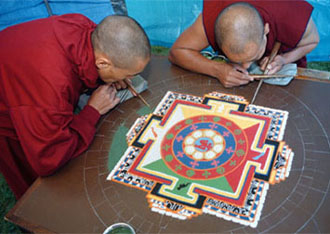
Tibetan Buddhist monks create a mandala sand painting. |
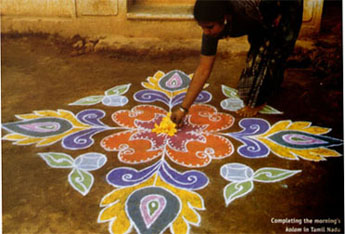
A Hindi woman prepares the morning kolam in India. |
Symbols of Faith
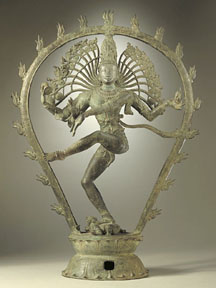
Shiva, Lord of the Dance 950 CE |
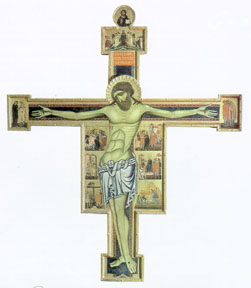
Gothic Christ, 10-11th c. CE |

Athena, 5th c. BCE |
Religious Architecture
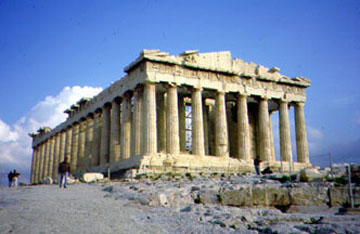 The Parthenon
The Parthenon, Athens, Greece 447-432 BCE |
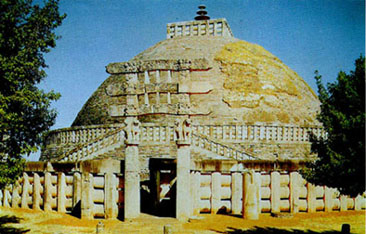 The Great Stupa
The Great Stupa, Sanchi, India 3rd-1st c. CE |
The Parthenon is the crowning glory of Athens, sitting at
its highest point on the hill of Acropolis (the center of political and
religious activities). Only priests were allowed into the inner chambers
and the worshippers gathered outside for ceremonial processions. The decorations
therefore faced outward, covering the pediments and friezes along each side
of the building.
Since Buddhism is a religion focused more on personal practice
than social ceremonies, the worshippers gathered inside. Elaborate decorations
cover four gateways on each side of the building. The purpose is
to bring the worshipper into the intimate space of meditation on the Buddhist
path, as the worshipper walks around the entire building before entering.
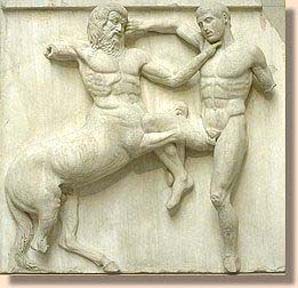
Parthenon Frieze (fragment from south side) |
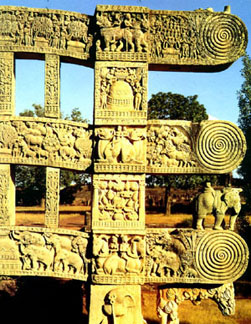
Sculptural Relief on Stupa Gate |
| Sculptural reliefs were placed on all sides
of the Parthenon, depicting the gods and various mythical battles. The
north side showed scenes from the Trojan war; the south side showed a
battle between the Greeks and the Centaurs -- part man, part horse; the
east side showed the Olympian gods fighting giants and the west side showed
a battle between Greeks and Amazons. |
The gateway surrounding the Great Stupa contains
reliefs depicting tales of Buddha's incarnations, his life as a prince,
his moment of enlightenment, his sermons and his worshippers. The spiraling
circle represents the Wheel of Life, symbolizing the eternal Buddhist
path. |
Political and Social Purposes of Art
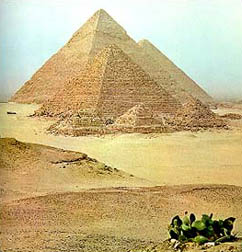 Great Pyramids of Giza
Great Pyramids of Giza, 2570-2500 BCE |
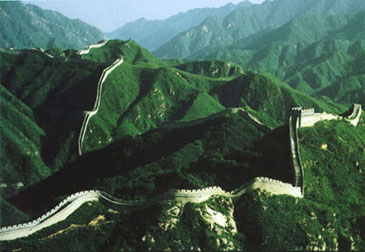 The Great Wall of China
The Great Wall of China, 228 BCE- 17th c. CE |
Though the essential purpose of the Great Pyramids was as tombs for the
kings, perhaps even more important were as symbolic statements of the kings'
power. By erecting the largest structures ever known to mankind, they insured
that they would never be forgotten. Thousands of workers were needed to
erect each, and the largest (Cheops') stands 450 feet tall, covering more
than 13 acres, and containing over 2.3 million blocks of megalithic stone.
The Great Wall of China is even more immense in scale, stretching over
more than 2000 miles (the distance from NYC to Denver). It averages 25 feet
wide and 25 feet high. Its purpose of keeping out foreign invaders was one
way to consolidate the power of the emperor.
Memorial to an Unpopular War
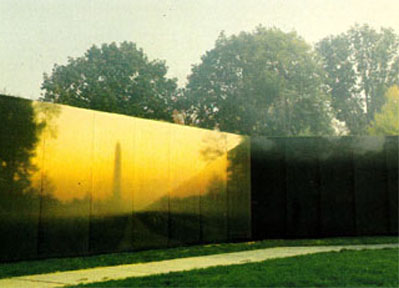 The Vietnam War Memorial
The Vietnam War Memorial, Maya Lin 1982 |
 Vietnam Heros
Vietnam Heros, Frederick Hart 1984 |
The idea for a memorial came from a Vietnam veteran named Jan Scruggs.
After watching the film "The Deer Hunter", he organized a group of veterans
to petition the government to fund the first memorial to commemorate the
soldiers who were lost in this unpopular war. Congress authorized the
Vietnam Veterans Memorial in 1980, stating that it would be located prominently
on the National Mall on two acres of Constitution Gardens. Following a
contest involving over 1400 entries, a jury selected the design of Maya
Ying Lin of Athens, Ohio, who at the time was a 21-year old architectural
student at Yale University. The Wall was built in 1982 and immediately
drew criticism from various veterans groups. Because of its minimalist
design and its use of black granite stone which directly sliced into the
landscape, the wall was dubbed by its critics "the black gash of
shame" or a "giant tombstone."
In an attempt to appease those who wanted a more heroic and representational
memorial, it was decided to add Frederick Hart's Statue of the Three Servicemen
to the overall design .in 1984. Nine years later, in 1993, the Vietnam
Women's Memorial was added women to honor the women who served and sacrificed
during the Vietnam War.
Despite the original controvercy, The Wall is the most beloved of the
memorials, and people who come to visit it rarely leave without being
touched by it. Many leave momentos of letters, dogtags, flags, and personal
possessions of those they knew who died in the Vietnam war. A museum was
set up to collect and display these items. |
The Names Project: AIDS Memorial Quilt
(displayed on the Mall at Washington, D.C. in Oct 1996)
The Names project's AIDS memorial quilt commerates
the lives of people throughout the country and world who have died of AIDS.
The quilt was the idea of Cleve Jones, a San Francisco gay rights activist.
After the loss of his dear friend Marvin Feldman, Jones made a tapestry in
his memory. The idea caught on quickly and soon Jones was joined by others
who had lost loved ones to AIDS. The quilt was first displayed in October
of 1987 during the March on Washington for Lesbian and Gay Rights and then
consisted of 1,920 panels. When it was displayed again in Washington in 1992,
it had grown to more than 20,000 panels. That covered the eqivalent of 12
football fields and weighed 30 tons. It now consists of over 25,000 panels.
Each panel, created by lovers, family and friends, includes items which reflect
the personality and life of those who have died. As with Cleve Jones original
tapestry, each panel measures three foot by six foot, the size of a human
grave. Sections of the quilts are now on display at various museums, universities
and organizations throughout the country.
Political Protest
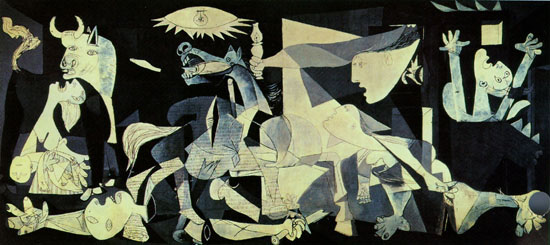
Pablo Picasso's Guernica, 1937 (11'5" x
25'5")
| When Picasso was commissioned to create a paintng for the Spanish pavillion
of the Paris Word's Fair, the artist procrastinated - until he was moved
by an event that propelled his righteous anger. The Nazi regime took advantage
of a Spanish civil war and gained permission from General Franco to bomb
the Northern Spanish town of Guernica in exchange for military aid. Defenseless
and unprepared, the town was demolished and its people massacred. The
huge mural's stark imagery is expressive of the Spanish artist's anguish
at the senseless brutality of the event. Details convey a screaming woman
holding her dead child, a terrified horse, a dead man and a woman screaming
in a burning house. The bull might symbolize the brutal forces of the
invasion while the woman holding a light might possibly contain the only
element of hope in this black, white, and grey world. |
Art as Mirror of Everyday Life
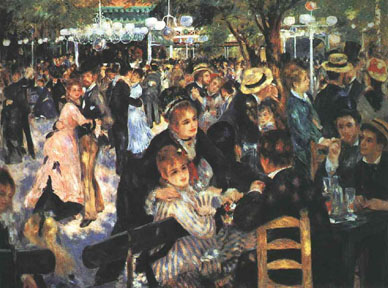
Pierre-Auguste Renoir, Le Moulin de la Galette, 1876 |
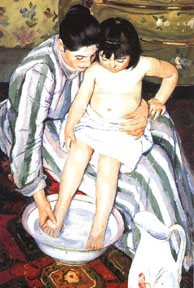
Marie Cassatt, The Bath |
The Impressionists were a group of artists famous for turning away
from allegorical, religious and political subjects in favor of images
of daily life, particularly that of their own social group, the rising
middle class. Art that depicts the casualness of everyday life and
its settings is often referred to as genre painting.
Some other examples of the elevation of daily events as a worthwhile
subject for art can be found in Persian miniature painting and is
also the subject of many Japanese woodblock prints.
|
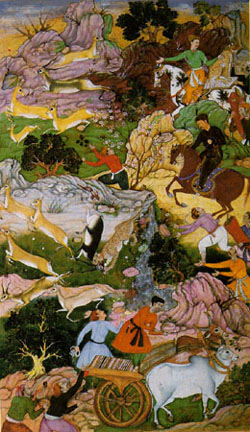
Persian Miniature, Abkar Hunting, 1590 |

Japanese Woodblock Print |
Art and Nature

Frederick Church, Catopaxi 1862 |

Joseph Turner, The Slave Ship 1840 |
| In Western art, most landscape painting was reserved for the backdrop
of paintings (the foreground usually focussing on an allegorical or religious
event). It was not until the 19th century that Nature was truly considered
as a subject unto itself. Frederick Church, an American, chooses to focus
on the glory and grandeur of the natural world, using dramatic lighting
and a painting of grand scale. Joseph Turner's nature is also dramatic,
but is more turbulent in his choice of a slave ship caught in a storm.
His brushstrokes were also very thick and expressionistic. |
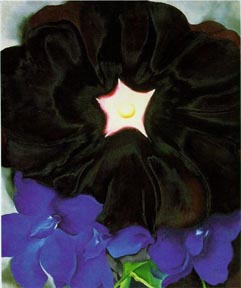
Georgia O'Keefe, Black Hollyhock 1929 |

O'Keefe, Black Iris |

Georgia O'Keefe, Red Flower |
Georgia O'Keefe's paintings focus on nature on a very intimate level.
An early series of works were large canvases of small flowers. It
is the lyrical abstraction of these flowers that make them personal
statements rather than simply reproductions of what the eye sees.
|
Art of Imagination and Fantasy

Salvador Dali, The Temptation of St. Anthony, 1946 |
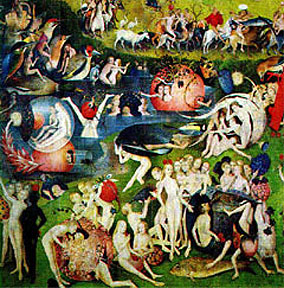
H. Bosch, The Garden of Earthly Delights, 1505 |
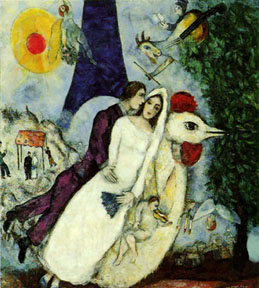
Marc Chagall, The Bride & Groom of the Eiffel Tower, 1938 |
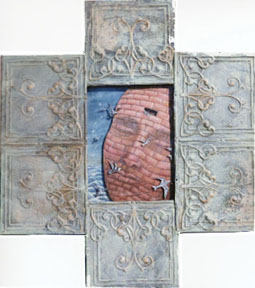
Robin Urton, Meditation Dream, 1996 |
Next: Asian Art
|














